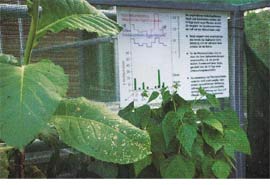|
|
|
|
|
|
 |
TOPICS OF
CURRENT INTEREST
|
>
 New VDI-Guidelines New VDI-Guidelines |
>
 The office has moved The office has moved |
> New
 Greenhouses Greenhouses |
> On the
 Landesgartenschau Landesgartenschau |
 |
Biomonitoring site on the Landesgartenschau in Plochingen/Neckar (Baden-Württemberg, Germany)
During the Landesgartenschau 1998 in Plochingen (Neckar), a biomonitoring station was set up to demonstrate the effects of ground-level ozone on susceptible plants:
Tobacco plants, represented by the highly susceptible variety 'Bel W3' and Pinto bean were exposed at biweekly intervals in order to indicate the visible effects of ozone near the ground during the growing season.
An Air Quality Monitoring Station, part of the state-wide Air Quality Monitoring Network, which was situated nearby, allowed numeric results of real-time air quality measurements to be displayed.
|
|

At the biomonitoring station diagrams illustrate the relationship between ozone air pollution and visible plant injury |
|
Episodes of elevated ambient ozone concentrations occurrred during the summer season: Sunny weather together with emissions mainly from automotive traffic in Mid May and, again, in mid August, resulted in alarmingly high ozone concentrations.
The response of the monitoring plants is clearly visible:
More than 30 % of the leaf area of tobacco plants were seriously injured by necrosis within a few days. In Pinto bean, which is somewhat less susceptible, ozone damaged about 5 % of the leaf area.
Ambient ozone pollution during the summer season is not only a problem for american bean cultivars like Pinto bean, or to tobacco, a rather exotic plant in central Europe. European farmers notice that ground-level ozone causes considerable damage even in our region:
Yield losses up to 25 % are measured in crops like wheat or in grape vine, when ozone concentrations peak. This occurs almost every year in Central Europe, and often hits the plants during the most susceptible stage of their development.
|
|

Time course of visible leaf injury in susceptible monitoring plants (tobacco 'Bel W3; 'Pinto' bean) and of ambient ozone concentration at the monitoring station "Landesgartenschau Plochingen" in 1998
|
|